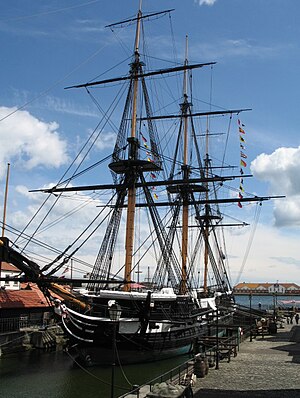HMS Trincomalee

Trincomalee in her current location in Hartlepool
|
|
| History | |
|---|---|
|
|
|
| Name: | HMS Trincomalee |
| Operator: | Royal Navy |
| Ordered: | 30 October 1812 |
| Builder: | Bombay Dockyard |
| Laid down: | 25 April 1816 |
| Launched: | 12 October 1817 |
| Out of service: | 1986 |
| Renamed: |
|
| Status: | Museum ship, Hartlepool, England |
| General characteristics | |
| Class and type: | Leda-class frigate |
| Tons burthen: | 1065.63 bm |
| Length: |
|
| Beam: | 39 ft 11.25 in (12.1730 m) |
| Depth of hold: | 12 ft 9 in (3.89 m) |
| Sail plan: | Full-rigged ship |
| Complement: | 315 officers and men |
| Armament: |
|
HMS Trincomalee is a Royal Navy Leda-class sailing frigate built shortly after the end of the Napoleonic Wars. She is now restored as a museum ship in Hartlepool, England.
Trincomalee is one of two surviving British frigates of her era—her near-sister HMS Unicorn (of the modified Leda class) is now a museum ship in Dundee. After being ordered on 30 October 1812, Trincomalee was built in Bombay, India by the Wadia family of shipwrights in teak, due to oak shortages in Britain as a result of shipbuilding drives for the Napoleonic Wars. The ship was named Trincomalee after the 1782 Battle of Trincomalee off the Ceylon (Sri Lanka) port of that name.
With a construction cost of £23,000, Trincomalee was launched on 12 October 1817. Captain Philip Henry sailed her to Portsmouth Dockyard where she arrived on 30 April 1819, with a journey costing £6,600. During the maiden voyage the ship arrived at Saint Helena on 24 January 1819 where she stayed for 6 days, leaving with an additional passenger, a surgeon who had attended Napoleon at Longwood House on the island, Mr John Stokoe.
After being fitted out at a further cost of £2,400, Trincomalee was placed in reserve until 1845, when she was re-armed with fewer guns giving greater firepower, had her stern reshaped and was reclassified as a sixth-rate spar-decked corvette.
Trincomalee departed from Portsmouth in 1847 and remained in service for ten years, serving on the North American and West Indies station. During her time, she was to help quell riots in Haiti and stop a threatened invasion of Cuba, and serve on anti-slavery patrol. In 1849, she was despatched to Newfoundland and Labrador before being recalled to Britain in 1850. In 1852 she sailed to join the Pacific Squadron on the west coast of America.
...
Wikipedia
